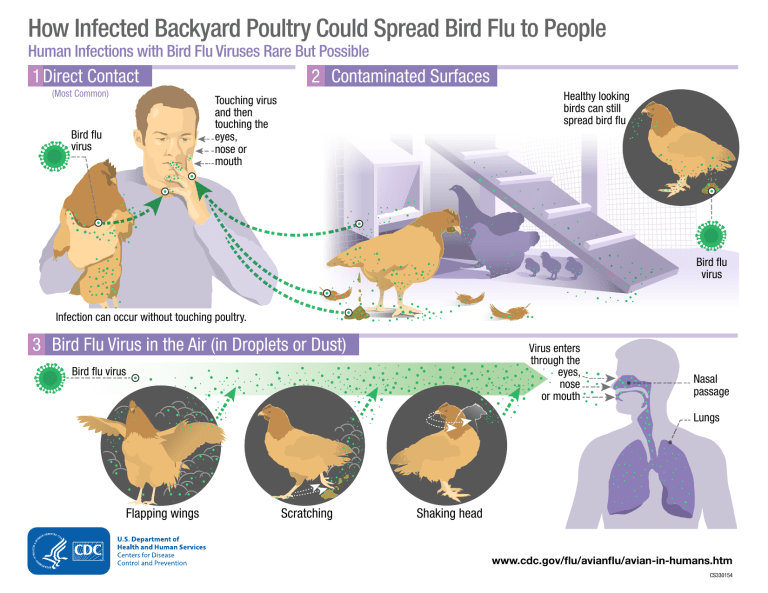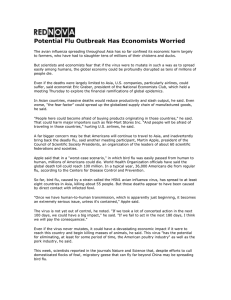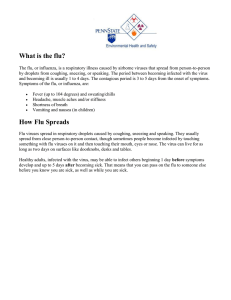
How Infected Backyard Poultry Could Spread Bird Flu to People Human Infections with Bird Flu Viruses Rare But Possible 1Direct Contact (Most Common) 2 Contaminated Surfaces Healthy looking birds can still spread bird flu Touching virus and then touching the eyes, nose or mouth Bird flu virus Bird flu virus Infection can occur without touching poultry. 3 Bird Flu Virus in the Air (in Droplets or Dust) Virus enters through the eyes, nose or mouth Bird flu virus Nasal passage Lungs Flapping wings Scratching Shaking head www.cdc.gov/flu/avianflu/avian-in-humans.htm CS330154 Bird flu infections in people are rare, but possible. Most reported bird a person touches something that has virus on it and then touches their flu infections in people have happened after unprotected contact with mouth, eyes or nose. (See picture on reverse side.) Most bird flu infections infected birds or contaminated surfaces. This fact sheet provides in people have happened after close, prolonged, unprotected contact with information about bird flu and bird flu infections in people. infected birds or contaminated surfaces. People who are sick with bird flu virus infection can be treated with the same prescription drugs that are Bird Flu in Wild Birds Wild water birds (like ducks and geese) can be infected with avian (bird) influenza (flu) viruses, but usually do not get sick. Infected birds have virus in their saliva, mucous and droppings (feces). Bird flu viruses can spread easily between birds. Some of these viruses can cause serious illness and death in domestic poultry (like chickens, ducks, and turkeys). used to treat people who are sick from human seasonal flu virus infection. People who have had no contact with infected poultry or contaminated surfaces are thought to be at very low risk of infection. People with close, prolonged, unprotected exposure with infected birds or contaminated environments are thought to be at greater (though probably still low) risk of infection. No human bird flu infections have been reported from proper handling of Bird Flu in Poultry poultry meat or from eating properly cooked poultry or poultry products. Domesticated birds (chickens, turkeys, ducks, etc.) can become infected with bird flu A viruses through direct contact with infected waterfowl or Bird Flu Outbreaks in Birds other infected poultry, or through contact with surfaces that have been Outbreaks of bird flu happen among birds from time to time. When bird contaminated with the viruses. Bird Flu is a serious poultry disease and flu outbreaks happen in U.S. poultry, the United States Department of requires rapid response because it is highly contagious and can be fatal Agriculture (USDA ) works with industry, state and other government to chickens. Animal and Plant Health Inspection Service (APHIS) works partners to stop the outbreak so that it does not spread to other poultry. with its federal, state, local and industry partners to quickly respond to any Surveillance of flocks that are nearby or linked to the infected flock(s) bird flu findings. Bird flu A(H5) or A(H7) virus outbreaks in poultry, where and quarantine of exposed flocks with culling if disease is detected, are depopulation (or culling, also called “stamping out”) of infected flocks is the preferred control and eradication methods. The Centers for Disease usually carried out. Control and Prevention works with partners to protect the public’s health during these outbreaks. The risk to the public from bird flu outbreaks is Bird Flu in People It is rare for people to get infected with bird flu viruses, but it can happen. low; however, because other bird flu viruses have infected people, it is possible that human infections with these viruses could occur. Bird flu viruses can infect people when enough virus gets into a person’s eyes, nose, or mouth, or is inhaled. This might happen when virus is in the air (in droplets or possibly dust) and a person breathes it in, or when More information about bird flu is available at www.cdc.gov/flu/avianflu




